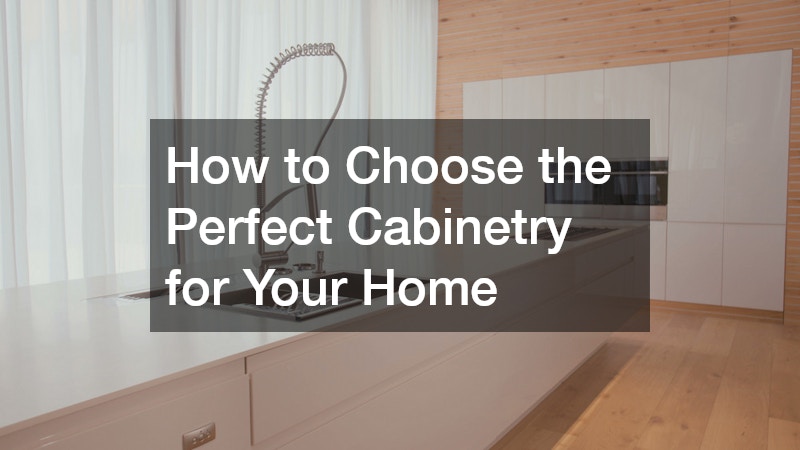
Choosing the perfect cabinetry for your home can significantly enhance both the functionality and aesthetics of your space. The right cabinetry not only provides essential storage but also works as a statement piece within your home. With countless styles, materials, and finishes available, making a decision can feel overwhelming.
Video Source
However, by considering a few essential factors, you can select cabinetry that perfectly suits your needs and complements your design vision. This article will guide you through the key points to help you find the ideal cabinetry for your home.
Before diving into specific styles, it's crucial to assess your space and layout. Take precise measurements of the area where you plan to install cabinetry, as this will determine the size and shape of the cabinetry you will need. Consider the flow of the room and how the cabinetry will interact with other elements, such as countertops, appliances, and furniture. Additionally, think about the overall purpose of the cabinetry—whether it's primarily for style or storage will influence your decision-making. A well-planned layout will ensure your cabinetry enhances the functionality of your home.
Once you have a clear understanding of your space, it's time to think about the type of cabinetry that will fit best. For instance, open shelving is excellent for a casual and airy feel, while closed cabinets provide a more sophisticated look while concealing clutter. Consider whether you want upper and lower cabinets or a combination of different types of cabinetry. Furthermore, evaluate how much storage you need; if you have a smaller area, consider vertical storage solutions to make the most of your space. Taking measurements and understanding your layout will guide you toward the right cabinetry choices.
Choosing the right material and finish for your cabinetry is just as important as considering size and layout. Common materials include solid wood, plywood, and engineered wood, each with its benefits and drawbacks. Solid wood cabinetry is durable and brings a classic look, while plywood offers flexibility and affordability. On the other hand, engineered wood materials can provide a modern aesthetic at a lower price point. Understanding the strengths and weaknesses of each material will help you make an informed decision.
In addition to the material, the finish plays a critical role in the overall look and feel of your cabinetry. Popular finishes range from natural stains that showcase the wood’s grain to paint that allows for more color variety. A matte finish can create a sophisticated look, while a glossy finish may provide a contemporary touch. It’s also essential to consider how finishes will hold up against wear and tear over time. Selecting a finish that balances beauty with practicality will ensure your cabinetry lasts for years to come.
While it can be tempting to tackle cabinetry selection on your own, enlisting the help of a professional can yield significant benefits. Designers have their finger on the pulse of current trends and can offer invaluable insights into what will work best for your space. They can assist in creating a customized cabinetry solution that fits your specific needs and preferences. Moreover, experienced professionals understand the nuances of working with different materials and can help you avoid costly mistakes. Collaborating with a professional can streamline the process and yield a result that aligns with your vision.
Additionally, professionals can provide access to a wider range of cabinetry options than might be available in typical retail outlets. They typically have connections with manufacturers, which may lead to better pricing and customized solutions that are not off-the-shelf. Engaging with a designer or contractor ensures that all regulatory requirements will be addressed, especially for more complex installations. They can provide guidance on installation methods and suggest the best practices tailored to your specific scenario, minimizing potential hassles. Ultimately, partnering with a professional ensures you're getting the highest quality cabinetry tailored to your home.
When choosing cabinetry, it's essential to establish a budget upfront. Knowledge of how much you are willing to spend will guide your choices and help narrow down your options. Take into account not only the cost of the cabinets themselves but also any installation and finishing expenses that may arise. Proper budgeting will help you prioritize features and materials that matter most to you while ensuring you stay within your financial limits. A well-planned budget can also save you from unexpected costs down the line, allowing for a smoother selection process.
It's also wise to allocate funds for unforeseen circumstances that may arise during installation or renovations. Improper measurements or material availability can lead to additional charges, so ensuring you have a contingency in place will help. By being prepared for these potential situations, you can prevent them from derailing your cabinetry project. Consider discussing your budget with professionals early on; they can recommend styles and materials within your budget range. This proactive approach allows you to explore various cabinetry options without overspending.
Finally, remember that high-quality cabinetry often proves to be a more sustainable investment in the long run. While it may require a more substantial upfront cost, durable cabinetry can reduce the need for replacements and repairs, ultimately saving you money over time. Prioritizing quality when selecting cabinetry could potentially benefit you financially and aesthetically in the long haul. Monitor sales and promotions in cabinetry stores, as this can be an excellent opportunity to snag high-quality materials at a reduced price. In this way, you can create your dream cabinetry while adhering to your budget.
